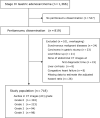An ascites grading system for predicting the prognosis of gastric cancer with peritoneum dissemination
- PMID: 33319156
- PMCID: PMC7726691
- DOI: 10.1002/ags3.12386
An ascites grading system for predicting the prognosis of gastric cancer with peritoneum dissemination
Abstract
Aim: Gastric cancer with peritoneum dissemination is intractable with surgical resection. The evaluation of the degree of dissemination using computed tomography (CT) is difficult. We focused on the amount of ascites based on CT findings and established a scaling system to predict these patients' prognoses.
Methods: We extracted individual data from a population-based cohort. Patients diagnosed with histologically proven gastric adenocarcinoma with peritoneum dissemination were enrolled. Two raters evaluated the CT images and determined the grade of ascites in each patient: grade 0 indicated no ascites in all slices; grade 1 indicated ascites detected only in the upper or lower abdominal cavity; grade 2 indicated ascites detected in both the upper and lower abdominal cavities; and grade 3 indicated ascites extending continuously from the pelvic cavity to the upper abdominal cavity. We evaluated the relationship between the ascites grade and survival time. After adjusting for other clinical factors, we calculated hazard ratios of each ascites grade.
Results: A total of 718 patients were enrolled. The number of patients with grades 0, 1, 2, and 3 were 303, 223, 94, and 98, respectively. The median overall survival times were 16.0, 8.7, 5.4, and 3.0 months for ascites on CT grades 0, 1, 2, and 3, respectively (P < .001). The adjusted hazard ratios for the survival time were 1.74 (1.33-2.26, P < .001), 3.20 (2.25-4.57, P < .001), and 4.76 (3.16-7.17, P < .001) for grades 1, 2, and 3, respectively.
Conclusion: We established a new grading system of pretreatment ascites to better predict the prognosis of gastric cancer.
Keywords: ascites; gastric cancer; peritoneal dissemination; prognosis.
© 2020 The Authors. Annals of Gastroenterological Surgery published by John Wiley & Sons Australia, Ltd on behalf of The Japanese Society of Gastroenterology.
Conflict of interest statement
Conflict of Interest: Authors declare no conflict of interests for this article.
Figures
References
-
- Yajima K, Kanda T, Ohashi M, Wakai T, Nakagawa S, Sasamoto R, et al. Clinical and diagnostic significance of preoperative computed tomography findings of ascites in patients with advanced gastric cancer. Am J Surg. 2006;192(2):185–90. - PubMed
-
- Kim SJ, Kim H‐H, Kim YH, Hwang SH, Lee HS, Park DJ, et al. Peritoneal metastasis: detection with 16‐ or 64‐detector row CT in patients undergoing surgery for gastric cancer. Radiology. 2009;253(2):407–15. - PubMed
LinkOut - more resources
Full Text Sources



